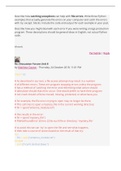Exam (elaborations)
COMP CS 1101 Discussion Unit 8 CS 1101- University of the People
- Course
- Institution
COMP CS 1101 Discussion Unit 8 CS 1101- University of the People/COMP CS 1101 Discussion Unit 8 CS 1101- University of the People/COMP CS 1101 Discussion Unit 8 CS 1101- University of the People/COMP CS 1101 Discussion Unit 8 CS 1101- University of the People/COMP CS 1101 Discussion Unit 8 CS 1101-...
[Show more]



